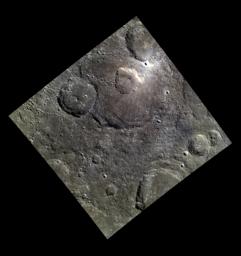
|
A Volcanic Crater in an Impact Crater
- Click the image above for a larger view
- Full-Res JPEG (1437 x 1528) (180.5 kB)
- Full-Res TIFF (1437 x 1528) (6.6 MB)
Caption:
Gibran, the large impact crater at the top of today's featured image, hosts a somewhat irregularly shaped 30-km-diameter pit. Such pits are thought to be related to shallow volcanic activity and to have formed due to the withdrawal of near-surface magma, causing the overlying surface to collapse. Impact craters like Gibran with interior volcanic pits are known as pit-floor craters . The color image shows that Gibran's pit does not have the dramatic red color of some explosive volcanic deposits seen on Mercury, consistent with a formation via collapse rather than eruption -- but ejecta from the fresh impact crater just to its north complicates the region. North is up in this image.
This image was acquired as part of MDIS's high-resolution 3-color imaging campaign. The map produced from this campaign complements the 8-color base map (at an average resolution of 1 km/pixel) acquired during MESSENGER's primary mission by imaging Mercury's surface in a subset of the color filters at the highest resolution possible. The three narrow-band color filters are centered at wavelengths of 430 nm, 750 nm, and 1000 nm, and image resolutions generally range from 100 to 400 meters/pixel in the northern hemisphere.
Date acquired:
April 20, 2013
Image Mission Elapsed Time (MET):
8771305, 8771297, 8771301
Image ID:
3917366, 3917364, 3917365
Instrument:
Wide Angle Camera (WAC) of the Mercury Dual Imaging System (MDIS)
WAC filters:
9, 7, 6 (996, 748, 433 nanometers) in red, green, and blue
Center Latitude:
34.75°
Center Longitude:
248.5° E
Resolution:
189 meters/pixel
Scale:
The pit at the top of the scene is approximately 30 km (19 mi.) across
Incidence Angle:
48.7°
Emission Angle:
0.2°
Phase Angle:
48.8°
Background Info:
The MESSENGER spacecraft is the first ever to orbit the planet Mercury, and the spacecraft's seven scientific instruments and radio science investigation are unraveling the history and evolution of the Solar System's innermost planet. MESSENGER acquired over 150,000 images and extensive other data sets. MESSENGER is capable of continuing orbital operations until early 2015.
For information regarding the use of images, see the MESSENGER image use policy .
Cataloging Keywords:
| Name | Value | Additional Values |
|---|---|---|
| Target | Mercury | |
| System | ||
| Target Type | Planet | |
| Mission | MESSENGER | |
| Instrument Host | MESSENGER | |
| Host Type | Orbiter | |
| Instrument | Mercury Dual Imaging System (MDIS) | |
| Detector | Wide Angle Camera (WAC) | |
| Extra Keywords | Color, Crater, Impact, Map, Radio, Volcano | |
| Acquisition Date | ||
| Release Date | 2013-05-16 | |
| Date in Caption | 2013-04-20 | |
| Image Credit | NASA/Johns Hopkins University Applied Physics Laboratory/Carnegie Institution of Washington | |
| Source | photojournal.jpl.nasa.gov/catalog/PIA17056 | |
| Identifier | PIA17056 | |
